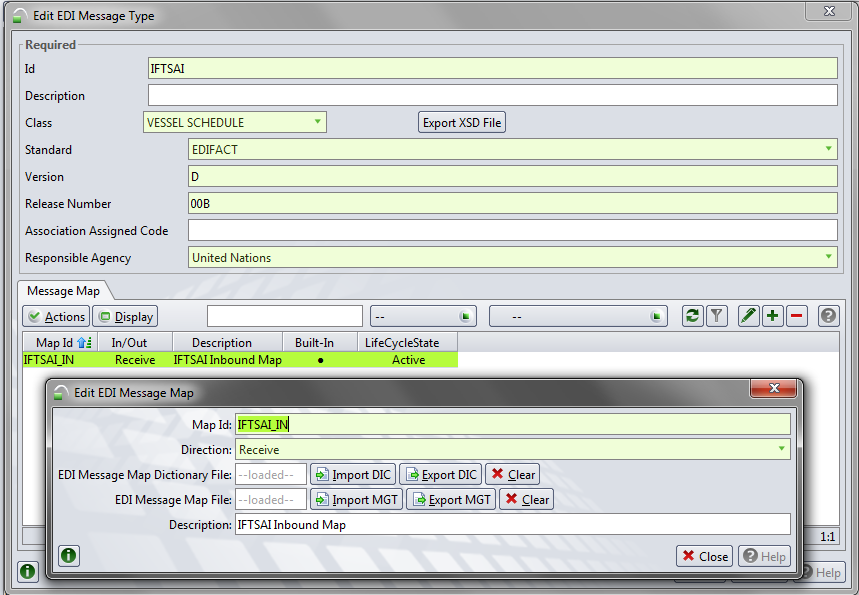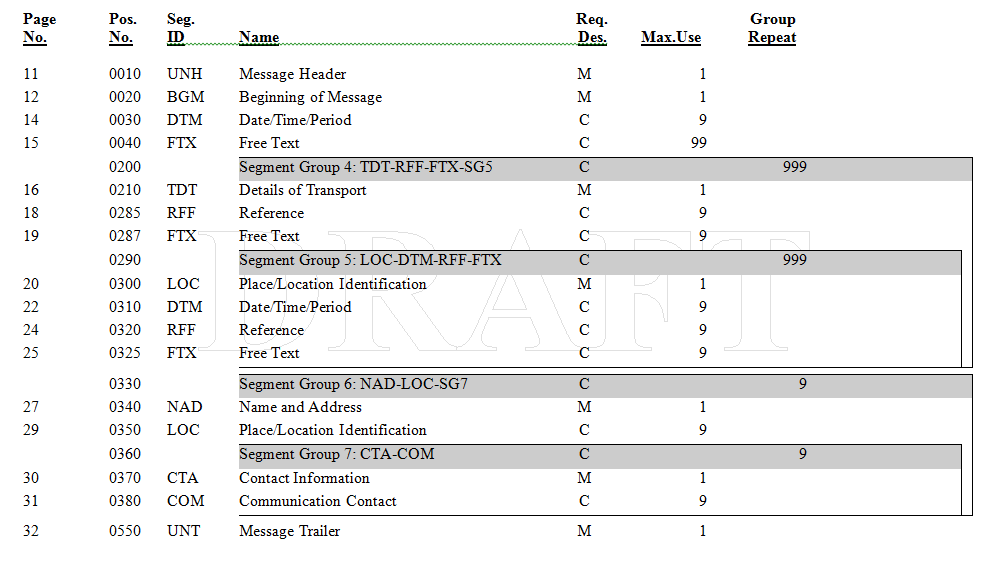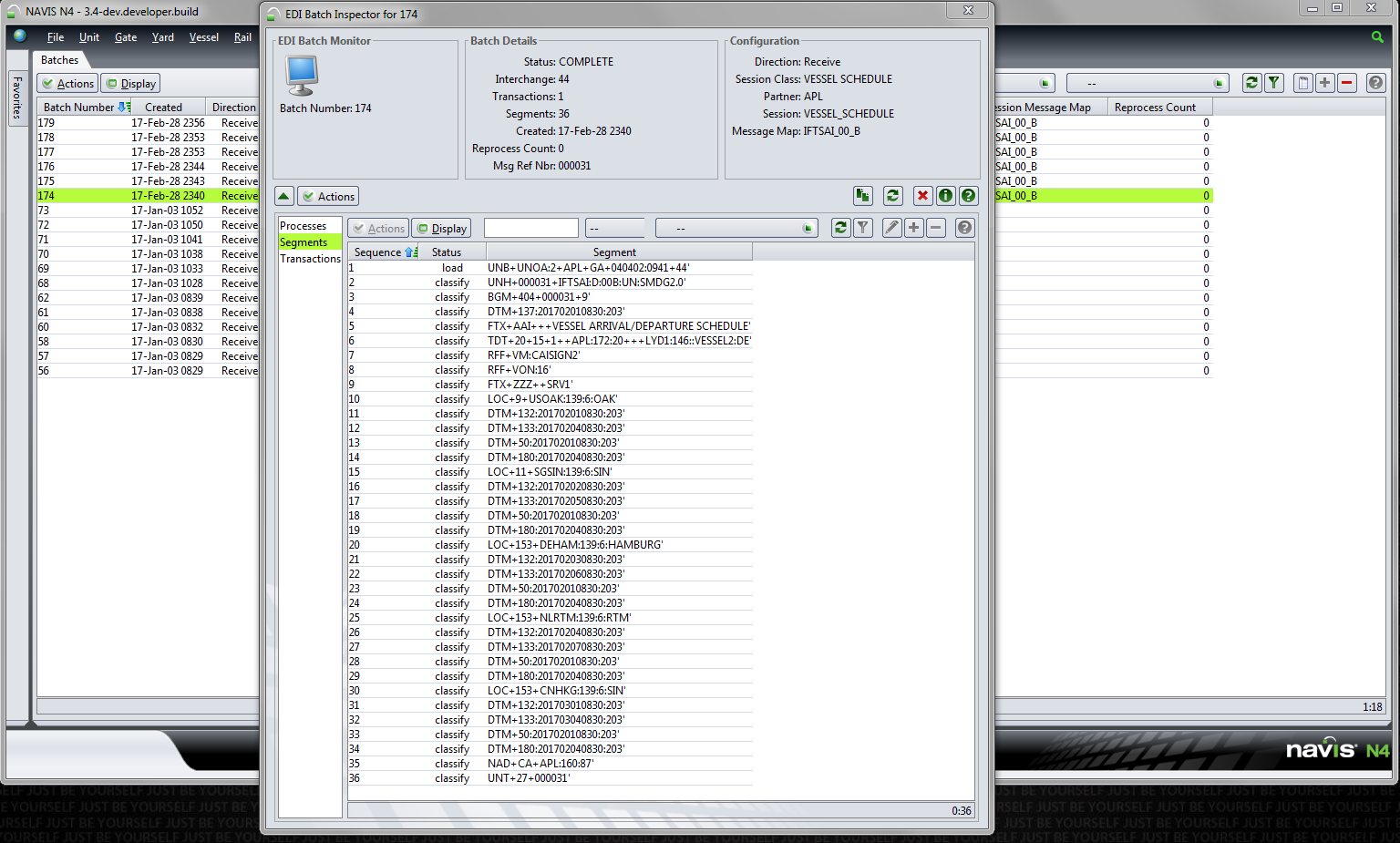
N4 supports EDIFACT standard IFTSAI message, release D & version 00B.
The purpose IFTSAI message is:
To exchange of vessel actual arrival/departure and vessel schedules with trading partners
To inform the parties of the long term schedule , mid term schedule, short term schedule or schedule updates, giving information on the actual vessel schedule information and container or cargo operations.
Shipping lines use the message for broadcasting regular schedule information to customers, port community centres, container terminals and amongst partner lines of shipping consortia.
The IFTSAI message is used to transmit a confirmation that a vessel has arrived or departed from a terminal, and can be used to confirm departure to a carrier, another terminal, or another interested party (such as a tracking service).
A IFTSAI EDI may contain:
Vessel Schedule
Carrier Service
Routing Points
The IFTSAI message is used to transmit a confirmation that a vessel has arrived or departed from a terminal, and can be used to confirm departure to a carrier, another terminal, or another interested party (such as a tracking service).
The information required reporting arrival and departure is identical, with the different functions being indicated by a different code in DE 1001 of the BGM segment. The ocean main carriage vessel/voyage is identified in segment group 4 Transport Schedule Details. The TDT segment includes voyage number, vessel operator, Lloyd’s number and vessel name. In segment 5 Schedule locations, the LOC segment identifies the port by the UN-Locode. The DTM segment identifies date and time of the vessel arrival or departure. Multiple combinations of vessel/arrival/departure are included in the same message by repeating the above segments.
The function of this message is to request transport schedule or availability information and to answer to such a request.
The IFTSAI vessel schedule message is recommended by SMDG as the message for use by ship owners, tonnage/operation centers , terminal operators, shipping lines etc.to exchange information about the vessel actual arrival/departure and vessel schedules with trading partners.
For information on the EDI message functions supported by IFTSAI, see Supported EDI message functions (on page 1).
"A message from/to a liner agent to/from a local authority (e.g. port authority), Container terminals , Schedule Portal or consortia member lines , to inform the parties of the long term schedule , mid term schedule, short term schedule or schedule updates, giving information on the actual vessel schedule information and container or cargo operations." Shipping lines use the message for broadcasting regular schedule information to customers, port community centers, container terminals and amongst partner lines of shipping consortia.

IFSTAI Inbound Supported Segments
The following picture illustrates the groups and their segments supported in EDIFACT standard IFTSAI D 00B message.

IFTSAI Inbound - Message Functions
The IFTSAI posting should do the following:
Original
Create Carrier Service (the segment from which service name should be picked to be discussed), carrier itinerary based on the LOC+153 segments (port calls), create vessel visit by attaching the service to the visit.
The vessel visit should have details like ETA/ETD/STA/STD (if sent in EDI)
The creation of Adhoc Vessel while posting IFTSAI should be governed by a setting.
The creation of port rotation based on the LOC segments should be governed by a setting
If creation of port rotation is allowed, then the port rotation should be created by including all the ports specified in the LOC segments like (LOC+9/11/153)
Creation of new vessel
If the vessel for which schedule is being sent in not available in the system, the vessel needs to be created in N4 based on a setting.
While creating new vessel, the following needs to be populated:
Vessel id : Lloyds's id or call sign needs to be used based on a setting
vessel name : as sent in EDI (TDT segment)
Lloyds' id : as sent in EDI (TDT segment)
Call sign : as sent in EDI (RFF+VM segment)
vessel class : UNKNOWN
Vessel classification : Deepsea
Line operator : as sent in TDT segment
New vessel should be created only when the message is original and message is sent by vessel operator (if already existing vessel).
If both Lloyds id and call sign not received in EDI, throw error.
Determination of Carrier Service Name:
Option 1:
Option to set Carrier service name should be provided in the batches screen (Update Carrier Service -> similar to the Update Carrier Visit to map the xml of a loadlist/dischlist/stowplan), instead of trying to determine it based on the port rotation of the IFTSAI-message (or at least it should be parametrized to keep all options open). Provide as well a column/field in the batches screen and EDI batch inspector to display the shipping line carrier service as an indicator to map it to the N4 Carrier Service.
Option 2:
Alternatively lines can send the service name in FTX segment (FTX+ZZZ) or in a mutually agreed segment/element.
Cutoff times
The various cut off times needs to be picked from the following DTM segments:
DTM+180 - Dry cutoff
DTM+50- Hazardout cutoff (Full)
Replace
Replaces all the service, vessel voyage rotation, Arrival/Departure information
Replaces all the portcalls with the new port call details specified in the EDI.
Only the main partner can send Replace message
The logic should be as follows:
Clear the existing itinerary
Repopulate the carrier service with the new itinerary
Change/Update
Updates only the affect port calls specified in the message (like ETA/ETD etc)
Other partners can update only their voyage number/cutoff details (seen in the Lines section of Vessel Visit Inspector). If there is no entry for the line in the Lines section, add an entry and update the respective voyage details.
If other partners send without main voyage, use vessel name with ETA to find the vessel visit
Delete
Deletes specific port calls only that are specified in the EDI.
Only the main partner/vessel owner can send the delete message
Add
Add specific port calls to the itinerary
For information on the EDI message functions supported by IFTSAI, see Supported EDI message functions (on page 1).
IFTSAI Inbound N4 Built-in Map
A new built-in map with map id "IFTSAI_IN" is added to N4. this map can be used to convert the IFTSAI EDI file into Navis standard XML format. This xml in turn used for further processing.
Following are the related files, part of N4 application and can be downloaded:
iftsai_D_00_B.mgt - GoXml map
iftsai.dic - Edifact standard dictionary
vesselschedule.xsd - Navis standard xml schema
4.1 How to Configure N4 for IFTSAI
To use IFTSAI in N4:
main partner - creates the visit
other partners - updates voyage nbr
main partner - updates ETA
Some considerations/validations:
If other partners send without main voyage, use vessel name with ETA to find the vessel visit
If IFTSAI EDI is sent for a vessel visit for updation past ETA, an error should be logged
When creating new vessel visit, the vessel visit phase should be inbound
Vessel visit should be created only when the message is sent by the vessel operator.
Partners should be allowed to update only their respective voyage details
Cancel is allowed only if the vessel visit phase is in created/inbound phase
Segments used to identify the vessel/voyage information:
TDT -> inbound voyage number; Lloyds number and vessel name
RFF+VM -> call sign
RFF-VON -> outbound voyage number
The IFTSAI posting should do the following:
Original:
Create Carrier Service (the segment from which service name should be picked to be discussed), carrier itinerary based on the LOC+153 segments (port calls), create vessel visit by attaching the service to the visit.
The vessel visit should have details like ETA/ETD/STA/STD (if sent in EDI)
The creation of Adhoc Vessel while posting IFTSAI should be governed by a setting.
the creation of port rotation based on the LOC segments should be governed by a setting
If creation of port rotation is allowed, then the port rotation should be created by including all the ports specified in the LOC segments like (LOC+9/11/153)
Creation of new vessel
If the vessel for which schedule is being sent in not available in the system, the vessel needs to be created in N4 based on a setting.
While creating new vessel, the following needs to be populated:
Vessel id : Lloyds's id or call sign needs to be used based on a setting
vessel name : as sent in EDI (TDT segment)
Lloyds' id : as sent in EDI (TDT segment)
Call sign : as sent in EDI (RFF+VM segment)
vessel class : UNKNOWN
Vessel classification : Deepsea
Line operator : as sent in TDT segment
New vessel should be created only when the message is original and message is sent by vessel operator (if already existing vessel).
If both Lloyds id and call sign not received in EDI, throw error.
Determination of Carrier Service Name:
Option 1:
Option to set Carrier service name should be provided in the batches screen (Update Carrier Service -> similar to the Update Carrier Visit to map the xml of a loadlist/dischlist/stowplan), instead of trying to determine it based on the port rotation of the IFTSAI-message (or at least it should be parametrized to keep all options open). Provide as well a column/field in the batches screen and EDI batch inspector to display the shipping line carrier service as an indicator to map it to the N4 Carrier Service.
Option 2:
Alternatively lines can send the service name in FTX segment (FTX+ZZZ) or in a mutually agreed segment/element.
Cutoff times
The various cut off times needs to be picked from the following DTM segments:
DTM+180 - Dry cutoff
DTM+50- Hazardout cutoff (Full)
Replace:
Replaces all the service, vessel voyage rotation, Arrival/Departure information
Replaces all the portcalls with the new port call details specified in the EDI.
Only the main partner can send Replace message
The logic should be as follows:
Clear the existing itinerary
Repopulate the carrier service with the new itinerary
Records the batch details in the Inbound EDI tab in the Vessel Inspector.
Updates the carrier visit in the Batches view (on page 1).
Change/Update:
Updates only the affect port calls specified in the message (like ETA/ETD etc)
Other partners can update only their voyage number/cutoff details (seen in the Lines section of Vessel Visit Inspector). If there is no entry for the line in the Lines section, add an entry and update the respective voyage details.
If other partners send without main voyage, use vessel name with ETA to find the vessel visit
Delete:
Deletes specific port calls only that are specified in the EDI.
Only the main partner/vessel owner can send the delete message
Add:
Add specific port calls to the itinerary
Cancel:
Records the batch details in the Inbound EDI tab in the Vessel Inspector.
Updates the carrier visit in the Batches view (on page 1).
Once the vessel visit is canceled, N4 updates the vessel visit phase to Canceled and records an event in the Vessel Inspector  History, Events tab.
History, Events tab.
Based on the following newly added settings, N4 controls the Vessel visits through the EDI message:
ARGOEDI013 (EDI_ADHOC_VESSEL_CREATION): If the setting is set to ALLOWED, N4 creates the vessel during the EDI IFTSAI message posting process. The Default value for this setting is NOT ALLOWED.
ARGOEDI014 (EDI_ADHOC_ITINERARY_CREATION): If the setting is set to ALLOWED, N4 creates the carrier itinerary during the EDI IFTSAI message posting process. The Default value for this setting is NOT ALLOWED.
ARGOEDI015 (EDI_VESSEL_ID_CONVENTION): You can select Call Sign or the Lloyds so that based on this value N4 creates the Vessel ID.
ARGOEDI016 (EDI_UNIQUE_VESSEL_VISIT_ID): You can select the format for the Vessel Visit ID for this setting. The values are MMYY, and SSS.
UNB+UNOA:2+APL+GA+040402:0941+44'
UNH+000031+IFTSAI:D:00B:UN:SMDG2.0'
BGM+404+000031+9'
DTM+137:201702010830:203'
FTX+AAI+++VESSEL ARRIVAL/DEPARTURE SCHEDULE'
TDT+20+14+1++APL01:172:20+++8407319:146:: Vessel Name:DE'
RFF+VON:14'
FTX+ACB++552+ZZZ+306+DGBK'
LOC+9+USOAK:139:6:OAK'
LOC+11+SGSIN:139:6:SIN'
LOC+153+DEHAM:139:6:HAMBURG'
LOC+153+NLRTM:139:6:RTM'
LOC+153+SGSIN:139:6:SIN'
LOC+153+USOAK:139:6:OAK'
NAD+CA+APL:160:87'
UNT+27+000031'
IFTSAI Inbound Test Instructions
The following section explains how to setup and test an IFTSAI message.
Pre-requisite for posting the IFTSAI EDI message
Create a session for IFTSAI message.

Posting the IFTSAI EDI message
Post IFTSAI Original message.

Ensure batch is completed without any error message and vessel visit is created